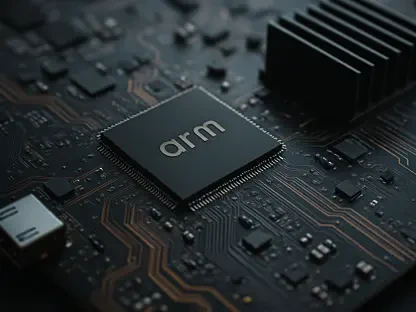Setting the Stage for Data Center Transformation
In an era where artificial intelligence drives unprecedented computational demands, data centers are grappling with a staggering challenge: energy consumption. Industry reports suggest that AI workloads could account for a significant portion of global electricity use by the end of this decade, pushing infrastructure to its limits. This pressing issue has thrust companies like Arm Holdings plc into the spotlight as they seek to redefine how data centers operate through innovative design and collaborative efforts.
The focus of this review is Arm’s strategic push into data center technology via its participation in the Open Compute Project (OCP), a global initiative dedicated to open-source hardware solutions. With energy efficiency at the forefront, Arm’s contributions aim to address the escalating power needs of AI-driven systems, setting a new benchmark for performance and sustainability in the industry.
This analysis delves into Arm’s cutting-edge approaches, from modular chip architectures to advanced packaging, and evaluates their potential to reshape data center infrastructure. By examining real-world applications and industry trends, the goal is to assess how these innovations stand up to current challenges and what they mean for the future of computing.
Diving into Arm’s Technological Advancements
Foundation Chiplet System Architecture (FCSA)
Arm’s Foundation Chiplet System Architecture (FCSA), an extension of its Chiplet System Architecture (CSA), represents a bold step toward modular and flexible hardware design. This specification stands out for its vendor-neutral and CPU architecture-neutral framework, allowing diverse components to integrate seamlessly into customized configurations. Such adaptability is crucial for optimizing performance per watt, a metric that has become a cornerstone for modern data center efficiency.
The significance of FCSA lies in its ability to tackle power constraints head-on. By enabling a mix-and-match approach to hardware, data center operators can tailor systems to specific AI workloads without being locked into rigid, one-size-fits-all solutions. This modularity not only boosts efficiency but also reduces the time and cost associated with developing specialized infrastructure.
Beyond flexibility, FCSA fosters collaboration across the industry by providing a standardized yet adaptable blueprint. As data centers face mounting pressure to scale sustainably, this architecture offers a pathway to balance high performance with energy conservation, addressing a critical pain point in today’s technology landscape.
Advanced Packaging Solutions
Another pillar of Arm’s innovation is its adoption of advanced 2.5D and 3D packaging technologies. These methods allow for the dense integration of compute, memory, storage, networking, and acceleration components into compact systems. The result is a significant leap in efficiency, as data transfer speeds increase and power consumption decreases due to reduced physical distances between elements.
This approach to packaging has tangible implications for data center design. By stacking components vertically or aligning them closely on a single plane, Arm’s technology minimizes latency and maximizes space utilization—an essential factor in environments where every inch and watt counts. Such advancements are particularly impactful for AI applications that demand rapid processing and vast data throughput.
The real-world potential of these packaging techniques extends to cost savings and scalability. As data centers evolve to handle larger workloads, the ability to pack more power into smaller footprints becomes a game-changer, positioning Arm as a key player in driving infrastructure toward greater density and performance.
Industry Dynamics and Collaborative Efforts
Shifting Paradigms in Data Center Design
The broader industry is witnessing a profound shift away from traditional, siloed data center architectures, where components operated in isolation. Instead, there is a growing emphasis on integrated, purpose-built systems that align hardware closely for maximum efficiency. Arm’s contributions align directly with this trend, prioritizing seamless interaction between disparate elements to enhance overall system output.
A notable driver of this transformation is the increasing role of original equipment manufacturers (OEMs) in custom silicon design. Moving beyond off-the-shelf solutions, OEMs are crafting tailored configurations to meet specific workload demands, a shift that underscores the need for performance per watt as a guiding principle. This metric has emerged as the gold standard for scaling AI infrastructure without exacerbating energy challenges.
Arm’s focus on energy efficiency resonates with this industry consensus. By championing designs that prioritize power optimization alongside raw performance, the company is helping to redefine how data centers are conceptualized and built, paving the way for more sustainable growth in the sector.
Partnerships and Real-World Impact
Arm’s influence extends through strategic collaborations, notably its involvement in the Ethernet for Scale-Up Networking (ESUN) initiative alongside industry giants like AMD, Nvidia, Microsoft, and Cisco. Unveiled at a recent OCP Global Summit, ESUN aims to enhance Ethernet networking capabilities to support the scale-up connectivity required for AI infrastructures, showcasing Arm’s commitment to interconnected solutions.
The practical applications of Arm’s technologies are evident across various sectors reliant on AI workloads. From cloud computing to edge processing, the modular chiplet approach allows for rapid customization, enabling developers to select components that best fit their needs without redesigning entire systems. This flexibility accelerates deployment and reduces innovation barriers.
Collaboration through platforms like OCP further amplifies Arm’s impact. By sharing knowledge, specifications, and intellectual property, the company contributes to a collective effort to standardize and improve data center technologies, ensuring that advancements are accessible and interoperable across different vendors and use cases.
Challenges in Implementation
Technical and Integration Hurdles
Despite the promise of Arm’s innovations, significant challenges remain in their implementation. Power limitations continue to pose a formidable barrier, as even the most efficient designs struggle to keep pace with the voracious energy demands of AI systems. Addressing these constraints requires not just technological breakthroughs but also systemic changes in how data centers manage resources.
The complexity of integrating diverse components into cohesive systems is another hurdle. While FCSA promotes modularity, ensuring compatibility and reliability across varied hardware configurations can be daunting. This integration challenge is compounded by the need for robust testing and validation processes to prevent performance bottlenecks or failures in high-stakes environments.
Industry-wide adoption of new standards like FCSA also faces resistance. Vendors accustomed to proprietary solutions may hesitate to embrace open, neutral frameworks, creating friction in the push for standardization. Overcoming this inertia demands persistent advocacy and demonstrable proof of the benefits that such architectures bring to the table.
Collaborative Solutions via OCP
Efforts within the OCP community are geared toward mitigating these obstacles through shared expertise and resources. By fostering an environment of open dialogue, OCP enables stakeholders to address integration complexities and power issues collectively, drawing on a wide pool of perspectives and experiences.
Arm’s active participation in this collaborative space is a step in the right direction. Through joint initiatives and knowledge exchange, the company is helping to refine its technologies and align them with industry needs, ensuring that solutions are both practical and scalable. This cooperative approach is vital for turning innovative concepts into widely adopted standards.
The ongoing work within OCP also focuses on building trust among vendors. By demonstrating the value of neutral architectures and modular designs, Arm and its partners aim to gradually shift mindsets, encouraging broader acceptance of new paradigms that prioritize efficiency and interoperability over traditional, closed systems.
Reflecting on Arm’s Contributions
Looking back, Arm’s foray into data center innovation through the Open Compute Project marked a significant milestone in addressing the intertwined challenges of performance and energy efficiency. The introduction of the Foundation Chiplet System Architecture and advanced packaging technologies provided a fresh perspective on designing infrastructure capable of supporting AI’s relentless growth. Collaborations like the ESUN initiative further underscored the power of partnership in driving meaningful progress.
As the industry continues to evolve, the next steps should center on accelerating the adoption of modular and efficient designs across diverse data center environments. Stakeholders must prioritize investment in scalable solutions that balance power demands with computational needs, while continuing to refine integration processes to minimize technical hiccups. Arm’s role in shaping these efforts remains pivotal, offering a blueprint for others to follow.
Beyond immediate actions, consideration should be given to long-term strategies that anticipate future AI workload surges. Exploring novel chiplet technologies and deeper industry alliances will be essential to stay ahead of energy constraints. Arm’s journey thus far suggests a promising trajectory, and sustained focus on collaboration and innovation will be key to transforming data center infrastructure for the decades ahead.









